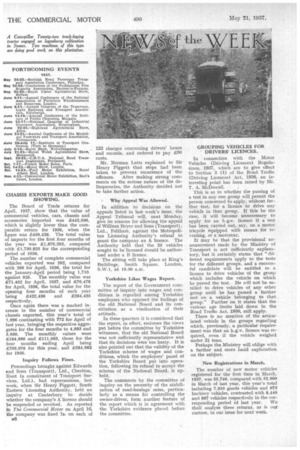GROUPING VEHICLES FOR ' DRIVERS' LICENCES.
Page 40

If you've noticed an error in this article please click here to report it so we can fix it.
In connection with the Motor Vehicles (Driving Licences) Regulations, 1937, which are to give effect to Section 3 (1) of the Road Traffic (Driving Licences) Act, 1936, an interesting point has been raised by Mr. T. A. McDowall.
This is as to whether the passing of a test in any one group will permit the person concerned to apply, without further test, for a licence to drive any vehicle in that group. If this be the case, it will become unnecessary to apply for an h.g.v. licence if a test has been carried out, say, on a motor tricycle equipped with means for reversing, or a motorcar.
It may be that the provisional announcement made by the Ministry of Transport is not sufficiently explanatory, but it certainly states that "different requirements apply to the tests for the different groups, and a successful candidate will be entitled to a licence to drive vehicles of the group which includes the vehicle on which he passed the test. He will not be entitled to drive vehicles of any other group until he has passed a further test on a vehicle belonging to that group." Further on it states that the various age limits laid down in the Road Traffic Act, 1930, still apply.
There is no mention of the articulated vehicle in the groups regarding which, previously, a particular requirement was that an h.g.v. licence was required, even if the vehicle weighed under 2itons.
Perhaps the Ministry will oblige with a further and more lucid explanation on the subject.
New Registrations in March.
The number of new motor vehicles registered for the first time in March, 1937, was 55,746, compared with 52,909 in March of last year, this year's total including 7,910 goods vehicles and 973 hackney vehicles, contrasted with 8,446 and 887 vehicles respectively in the cor
responding period of last year. We shall analyse these returns, as is our custom, in our issue for next week.




































































































